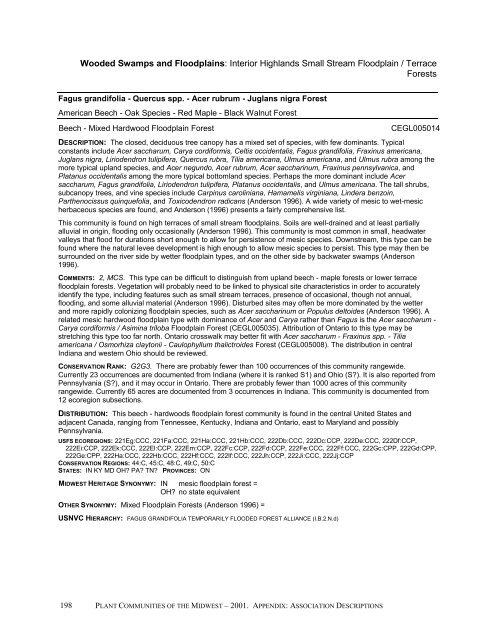Ohio subset of Plant Communities of the Midwest ... - NatureServe
Ohio subset of Plant Communities of the Midwest ... - NatureServe
Ohio subset of Plant Communities of the Midwest ... - NatureServe
Create successful ePaper yourself
Turn your PDF publications into a flip-book with our unique Google optimized e-Paper software.
Wooded Swamps and Floodplains: Interior Highlands Small Stream Floodplain / Terrace<br />
Forests<br />
Fagus grandifolia - Quercus spp. - Acer rubrum - Juglans nigra Forest<br />
American Beech - Oak Species - Red Maple - Black Walnut Forest<br />
Beech - Mixed Hardwood Floodplain Forest<br />
CEGL005014<br />
DESCRIPTION: The closed, deciduous tree canopy has a mixed set <strong>of</strong> species, with few dominants. Typical<br />
constants include Acer saccharum, Carya cordiformis, Celtis occidentalis, Fagus grandifolia, Fraxinus americana,<br />
Juglans nigra, Liriodendron tulipifera, Quercus rubra, Tilia americana, Ulmus americana, and Ulmus rubra among <strong>the</strong><br />
more typical upland species, and Acer negundo, Acer rubrum, Acer saccharinum, Fraxinus pennsylvanica, and<br />
Platanus occidentalis among <strong>the</strong> more typical bottomland species. Perhaps <strong>the</strong> more dominant include Acer<br />
saccharum, Fagus grandifolia, Liriodendron tulipifera, Platanus occidentalis, and Ulmus americana. The tall shrubs,<br />
subcanopy trees, and vine species include Carpinus caroliniana, Hamamelis virginiana, Lindera benzoin,<br />
Par<strong>the</strong>nocissus quinquefolia, and Toxicodendron radicans (Anderson 1996). A wide variety <strong>of</strong> mesic to wet-mesic<br />
herbaceous species are found, and Anderson (1996) presents a fairly comprehensive list.<br />
This community is found on high terraces <strong>of</strong> small stream floodplains. Soils are well-drained and at least partially<br />
alluvial in origin, flooding only occasionally (Anderson 1996). This community is most common in small, headwater<br />
valleys that flood for durations short enough to allow for persistence <strong>of</strong> mesic species. Downstream, this type can be<br />
found where <strong>the</strong> natural levee development is high enough to allow mesic species to persist. This type may <strong>the</strong>n be<br />
surrounded on <strong>the</strong> river side by wetter floodplain types, and on <strong>the</strong> o<strong>the</strong>r side by backwater swamps (Anderson<br />
1996).<br />
COMMENTS: 2, MCS. This type can be difficult to distinguish from upland beech - maple forests or lower terrace<br />
floodplain forests. Vegetation will probably need to be linked to physical site characteristics in order to accurately<br />
identify <strong>the</strong> type, including features such as small stream terraces, presence <strong>of</strong> occasional, though not annual,<br />
flooding, and some alluvial material (Anderson 1996). Disturbed sites may <strong>of</strong>ten be more dominated by <strong>the</strong> wetter<br />
and more rapidly colonizing floodplain species, such as Acer saccharinum or Populus deltoides (Anderson 1996). A<br />
related mesic hardwood floodplain type with dominance <strong>of</strong> Acer and Carya ra<strong>the</strong>r than Fagus is <strong>the</strong> Acer saccharum -<br />
Carya cordiformis / Asimina triloba Floodplain Forest (CEGL005035). Attribution <strong>of</strong> Ontario to this type may be<br />
stretching this type too far north. Ontario crosswalk may better fit with Acer saccharum - Fraxinus spp. - Tilia<br />
americana / Osmorhiza claytonii - Caulophyllum thalictroides Forest (CEGL005008). The distribution in central<br />
Indiana and western <strong>Ohio</strong> should be reviewed.<br />
CONSERVATION RANK: G2G3. There are probably fewer than 100 occurrences <strong>of</strong> this community rangewide.<br />
Currently 23 occurrences are documented from Indiana (where it is ranked S1) and <strong>Ohio</strong> (S). It is also reported from<br />
Pennsylvania (S), and it may occur in Ontario. There are probably fewer than 1000 acres <strong>of</strong> this community<br />
rangewide. Currently 65 acres are documented from 3 occurrences in Indiana. This community is documented from<br />
12 ecoregion subsections.<br />
DISTRIBUTION: This beech - hardwoods floodplain forest community is found in <strong>the</strong> central United States and<br />
adjacent Canada, ranging from Tennessee, Kentucky, Indiana and Ontario, east to Maryland and possibly<br />
Pennsylvania.<br />
USFS ECOREGIONS: 221Eg:CCC, 221Fa:CCC, 221Ha:CCC, 221Hb:CCC, 222Db:CCC, 222Dc:CCP, 222De:CCC, 222Df:CCP,<br />
222Ei:CCP, 222Ek:CCC, 222El:CCP, 222Em:CCP, 222Fc:CCP, 222Fd:CCP, 222Fe:CCC, 222Ff:CCC, 222Gc:CPP, 222Gd:CPP,<br />
222Ge:CPP, 222Ha:CCC, 222Hb:CCC, 222Hf:CCC, 222If:CCC, 222Jh:CCP, 222Ji:CCC, 222Jj:CCP<br />
CONSERVATION REGIONS: 44:C, 45:C, 48:C, 49:C, 50:C<br />
STATES: IN KY MD OH PA TN PROVINCES: ON<br />
MIDWEST HERITAGE SYNONYMY: IN mesic floodplain forest =<br />
OH no state equivalent<br />
OTHER SYNONYMY: Mixed Floodplain Forests (Anderson 1996) =<br />
USNVC HIERARCHY: FAGUS GRANDIFOLIA TEMPORARILY FLOODED FOREST ALLIANCE (I.B.2.N.d)<br />
PLANT COMMUNITIES OF THE MIDWEST – 2001. APPENDIX: ASSOCIATION DESCRIPTIONS<br />
198
















